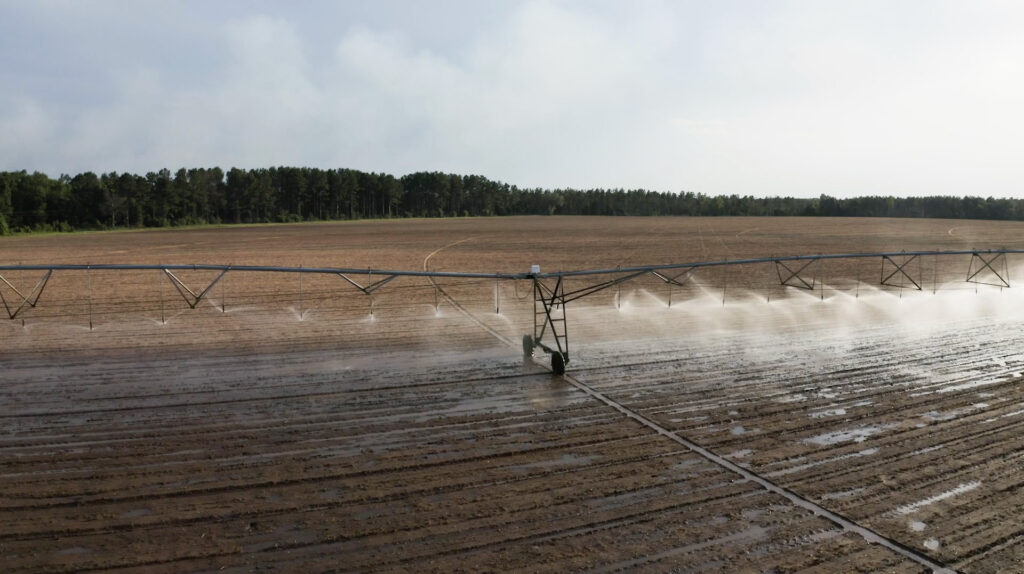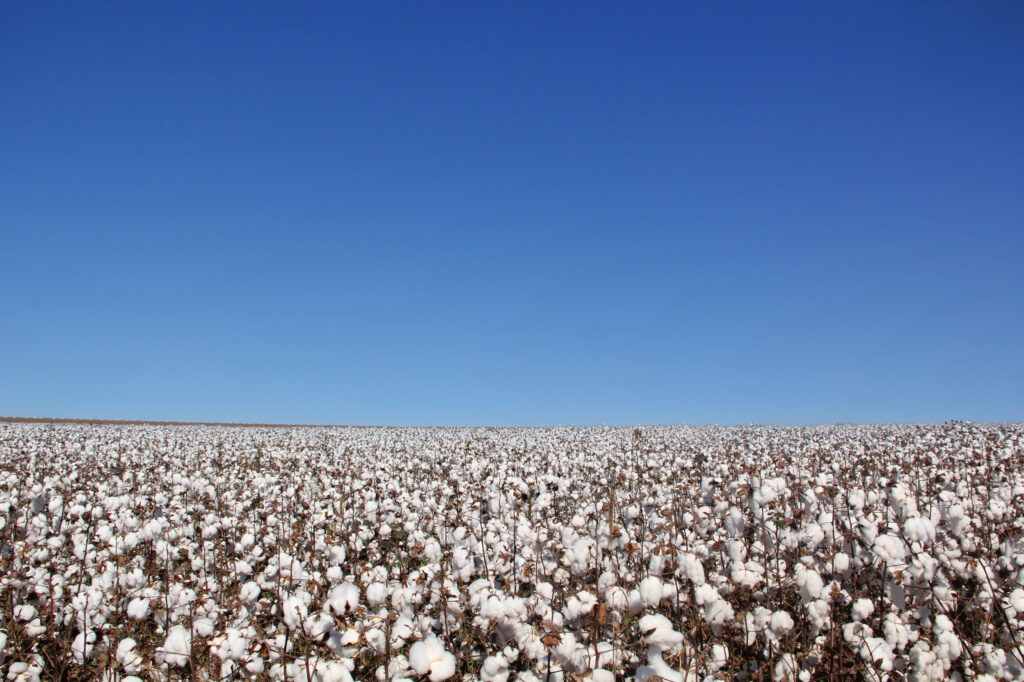Cotton Sustainability Fundamentals
Discover how cotton creates opportunities for sustainable textiles throughout its life cycle.
Sustainable Cotton: The Basics
Across disciplines, sustainability is defined as meeting present needs without compromising the ability of future generations to meet their needs. Sustainability is sewn into the cotton life cycle: from regenerative agriculture practices and sustainable processing techniques to its circular end of life possibilities.
Choosing sustainable fibers like cotton is good for the earth, and it’s good for business: Sustainable fabric was a clothing purchase driver for 79% of global survey respondents, and 83% of consumers perceive cotton as safe for the environment.1 Cotton can help support your brand’s sustainability goals.
Cotton growers, manufacturers, and others across the supply chain are working to keep cotton’s environmental impact as low as possible. Progress in sustainable cotton production is driven by innovative technologies, management systems, and conservation practices, all guided by science-based environmental goals.
Resource Efficiency in Cotton Production
Improving the sustainability of cotton production means using our natural resources more efficiently. U.S. cotton producers are leading the way in responsible cotton production practices that reduce water use, land use, soil loss, energy use, and pesticide use while increasing soil health and yield per acre.2
Water

Cotton is not a water-intensive crop. Cotton naturally tolerates drought and thrives in hot, dry conditions where water is scarce. For this reason, farmers around the world can cultivate cotton in areas where other crops would likely fail.
Seed cotton production only accounts for about 3% of all water used for crop production.3 In the U.S., 64% of cotton acreage needs no irrigation, as rainfall is sufficient.4 In the other areas, irrigation is typically reserved for dry spells.4
Saving water in cotton agriculture has progressed through sustainability-conscious decisions like transitioning from surface irrigation to sprinkler or drip irrigation systems, implementing improved water delivery systems, and applying irrigation scheduling tools.
Between 1980 and 2020 in the U.S., water application rates dropped 38%.5 The cotton industry is continuing to research technologies to more accurately determine crop water needs, optimally schedule irrigation, improve the precision of water delivery, and reduce water loss.
Soil and Land
Soil is agriculture’s most fundamental resource, so modern cotton production practices both limit erosion and increase soil health. It pays off: Healthy soil improves a crop’s chances for a higher yield, helps reduce plant stress during short-term drought or pest attacks, and reduces fertilizer inputs. This results in reduced production costs, better output for the farm, and less impact on the earth.
Many cotton growers use conservation tillage and cover crop practices to reduce erosion and protect soil health. Conservation tillage reduces the number of times soil is plowed, thus minimally disturbing the soil and keeping nutrients in place. Cover crops’ roots hold the soil in place, protect it from wind and rain, and the organic matter eventually degrades and nourishes the soil. One study linked conservation tillage to less soil erosion, better water quality, and an increased amount of carbon transferring from the air to the soil.6
Sustainability in cotton land use requires increased productivity (yield per acre), and productivity depends greatly on soil conservation and soil health. Through advanced technologies and research, the U.S. cotton industry has made great strides in increasing crop production and management practices.
Carbon
For companies developing and pursuing greenhouse gas (GHG) emission reduction strategies, materials matter. Addressing greenhouse gas emissions is a major component of sustainable U.S. cotton production.
Cotton production naturally sequesters carbon in the soil and in the fiber itself, transforming carbon dioxide and sunlight into cotton lint. The cotton plant is in fact very efficient at removing CO2 from the atmosphere, and its capacity to store it in the soil and fiber is only increasing.
Practices like cover cropping and no-till management significantly improve the soil’s carbon and water storage capacity. They keep the soil in place and healthy, which leads to soil that requires less fertilizer.
Energy

The primary energy expenditures in cotton production include fuel for agricultural equipment, electrical energy for ginning, and the energy used to manufacture fertilizers. The cotton industry has been intentional about reducing energy consumption, applying practices like no-till farming, site-specific management of inputs, and precise fertilizer application technologies. These advancements in equipment and practices help growers use less fuel while also helping them optimize their use of inputs like fertilizer and herbicides.
Reducing fertilizer losses through precision application — using the right amount at the right time — is a major focus for cotton energy efficiency research.
U.S. cotton energy use efficiency improved by nearly 31% between 1980 and 2020.5 This means today, less energy is required to produce a pound of cotton lint.
As new technologies are developed and adopted, energy use and greenhouse gas emissions in cotton production are expected to continue decreasing. Advancements in equipment efficiency, land management, and farming practices offer promising opportunities to reduce the energy footprint of cotton even further.
Pesticides
In the United States, more than 100 types of pests attack cotton, and if left unmanaged, these pests can devastate cotton crops. Efficiently and effectively reducing the amount of cotton lost to pests is critical for sustainability and grower profitability.
When pests damage cotton crops, less cotton can be produced per acre, and more fertilizer, tillage, or irrigation may be required to make up for decreased efficiency and plant health. Some pest control methods, like using herbicide-tolerant transgenic cotton varieties, also enable sustainable practices like reduced tillage and cover crops.
To steward the environment and preserve an abundant, high-quality cotton supply over the long term, the cotton industry is approaching pest control from multiple angles, including integrated pest management (IPM) and biotechnology.
In IPM, pesticides are never a first resort. Instead, cotton growers integrate multiple practices targeted at their specific needs, which they identify through ongoing data collection. This decreases potential hazards to people and the environment and mitigates the risk of pesticide-tolerant insects and weeds.
U.S. cotton growers are actively participating in enhanced pest management strategies that enable them to use the right pesticides, at the right times, in the right ways to effectively limit their overall usage.
Regenerative Agriculture and Precision Agriculture

U.S. cotton growers take pride in being good stewards — of both their businesses and the land they depend on. Stewardship guides every action they take to sustain and enhance the land for future generations. Regenerative agriculture is central to sustainable cotton. Field to Market® defines regenerative agriculture as farming methods that capture carbon while enhancing soil health, biodiversity, water, and air quality — all while keeping farms productive.7 Cotton farmers adopt these practices to safeguard both the land and their livelihoods: soil health management systems have been shown to boost net income per acre,8 keeping cotton in supply at a stable price.
Precision agriculture, made possible by modern technology, helps growers more accurately detect crop needs so they can use resources — including fertilizer, pesticides, and water — much more efficiently. These tools allow consultants and growers to collect information about how conditions vary within a field and then manage the crop accordingly.
Regenerative AgricultureNaturally Microplastic-Free
As a natural fiber, cotton is sourced directly from nature, not made synthetically. As a natural fiber, it can significantly break down in aquatic environments,9 returning to the earth and not contributing microplastic pollution to our waterways and ocean.
The global microplastic pollution problem is serious, but cotton provides a microplastic-free alternative to synthetics.
Natural vs. Synthetic FibersCircular End of Life Possibilities
There are circular pathways for all types of cotton-based products, from fabrics to nonwovens and more. Cotton offers possibilities to be reused, recycled,10 and returned to the earth.11
Reuse
When cotton textiles are well-made, they have exceptional durability and can last through many years of wear and washing while maintaining their quality. This extends the lifetime of cotton products and makes them ideal for secondhand markets. When cotton products are reused, new items need to be purchased less frequently, and less resources need to be spent on creating new products.
Return to Earth
Cotton can degrade in a range of aquatic environments12 and break down as nutrient-rich compost.11 Under the right conditions, cotton can degrade and be added to soil to grow plants — even more cotton.
Shaping the Future of Sustainable Textiles
From the farm to the finished product, cotton’s natural advantages and the industry’s ongoing commitment to progress make it a key material in building a more sustainable textile future. By choosing cotton, brands, retailers, and manufacturers can align with science-based goals, support responsible agriculture, and meet growing expectations for transparency and performance.
Page References
Cotton Council International & Cotton Incorporated 2023 Global Sustainability Survey, Wave 3 – survey of 7,101 women & men, ages 18-60 in the U.S., U.K., India, China, Mexico, Germany, and Italy who have involvement in clothes shopping.
Daystar, J. S., Barnes, E., Hake, K., & Kurtz, R. (2017). Sustainability trends and natural resource use in U.S. cotton production. BioResources, 12(1), 362-392. https://doi.org/10.15376/biores.12.1.362-392
Hoekstra, A. Y. & Chapagain, A. K. (2007). Water footprints of nations: Water use by people as a function of their consumption pattern. Water Resources Management, 21, 35-48. https://doi.org/10.1007/s11269-006-9039-x
United States Department of Agriculture National Agricultural Statistics Service. (2019). 2018 Irrigation and Water Management Survey, 3(1). https://www.nass.usda.gov/Publications/AgCensus/2017/Online_Resources/Farm_and_Ranch_Irrigation_Survey/fris.pdf
Field to Market: The Alliance for Sustainable Agriculture. (2021). Environmental Outcomes from On-Farm Agricultural Production in the United States. National Indicators Report, fourth edition. https://grains.org/wp-content/uploads/2023/11/Field-to-Market_2021-National-Indicators-Report_FINAL.pdf
Franzluebbers, A. J. (2010). Achieving Soil Organic Carbon Sequestration with Conservation Agricultural Systems in the Southeastern United States. Soil Science Society of America Journal, 74(2). https://doi.org/10.2136/sssaj2009.0079
Field to Market. (n.d.) Defining Sustainable and Regenerative Agriculture. Retrieved October 15, 2024 from https://fieldtomarket.org/defining-sustainability/
Soil Health Institute. (2022). Economics of Soil Health Management Systems on Five Cotton Farms. https://soilhealthinstitute.org/app/uploads/2022/03/Economics-On-Five-Cotton-Farms.pdf
Ankeny, M., Daystar, J., Goller, C. C., Pawlak, J. J., Venditti, R. A., & Zambrano, M. C. (2020). Aerobic biodegradation in freshwater and marine environments of textile microfibers generated in clothes laundering: Effects of cellulose and polyester-based microfibers on the microbiome. Marine Pollution Bulletin, 151. https://doi.org/10.1016/j.marpolbul.2019.110826
Cotton products are recyclable only in a few communities that have appropriate recycling facilities.
Li, L., Frey, M., & Browning, K. J. (2010). Biodegradability Study on Cotton and Polyester Fabrics. Journal of Engineered Fibers and Fabrics, 5(4). https://doi.org/10.1177/155892501000500406
Zambrano, M. C., Pawlak, J. J., Daystar, J., Ankeny, M., Cheng, J. J., & Venditti, R. A. (2019). Microfibers generated from the laundering of cotton, rayon and polyester based fabrics and their aquatic biodegradation. Marine Pollution Bulletin, 142, 394-407. https://doi.org/10.1016/j.marpolbul.2019.02.062